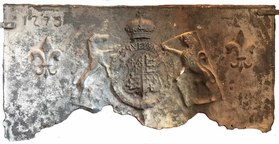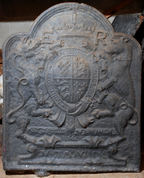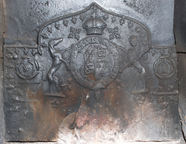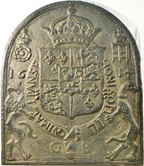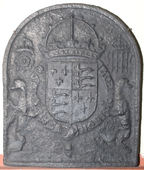-
1226
Description: Rectangular; rope edging (top & sides); in centre, Tudor shield, garter, crown and supporters (greyhound and lion) between two fleurs-de-lys; date top left.
Notes: A badly corroded fireback. The armorial achievement is seen on other firebacks and was formed from four separate stamps; the supporters are consistent with the date; the style of the numerals is uncharacteristic of the period. The sharpness of the detail on the crown and upper part of the Garter indicates that the fireback is contemporary with the date, and not older as similar examples seem to be. The same date in identical form is on a similar fireback at Penshurst Place, Kent.
Inscription: 1579 / [Garter motto incomplete]
Arms: Tudor royal
- Decoration tags:
- rectangular (shape)
- rope (edging)
- carved stamps
- date stamp
- heraldic
- armorial
- text
- animals
Manufactured: in 1579 in the Weald area of England.
Current location: Groombridge Place, Speldhurst, Kent, England.
- Attached to series:
- Tudor redated series
- Pounsley series
- Tudor royal armorial firebacks
-
89
Description: Quasi-arched rectangular shaped, with sides leaning slightly towards the top; wide ovolo edging (top and sides) with twisted rope relief; Tudor shield, garter, crown and supporters (crowned lion and dragon); motto along base; irregular ribbon behind.
Notes: Whole pattern; strong stylistic similarities with a Buckhurst arms fireback (no. 491), an example of which is at Michelham Priory, near Hailsham, East Sussex, suggest a common pattern maker and possibly furnace.
Inscription: DIEV ET MON DROI
Arms: Tudor royal (prob. Elizabeth I)
- Decoration tags:
- rectangular with round arch (shape)
- ovolo, simulated rope (edging)
- whole carved pattern
- armorial
- royal
- text
Manufactured: in the late-16th century in the Weald area of England.
Current location: Hampton Court, Richmond, Greater London, England.
Museum number: 1241 (part of the Royal Collection museum group)
- Attached to series:
- Ornate border series
- Tudor royal armorial firebacks
-
147
Description: Arched rectangular shape with rounded corners; ovolo within fillet moulding all round; oval Tudor royal shield with garter surrounding, topped with a royal crown; dragon and greyhound supporters; initials split by crown; inscription on a fillet between legs of supporters, behind garter finial; motto on an Ionic plinth at bottom.
Notes: The supporters are those of Henry VII or Henry VIII, but the initials suggest the fireback dates from the reign of Edward VI (1547-53). John Harvo (d. c1565) was a gunfounder who has been identified as occupying Pounsley furnace, Framfield, Sussex, possibly from as early as 1547. This fireback is also seen with a variety of rectangular, rope-edged side panels bearing stamps or letters, some of which link the source of this and other groups of firebacks. The pattern or model for this fireback may have been made during the reign of Henry VIII (1509-47), with the initials added to an early casting using the original pattern. The protuberance on the bottom of the plate may be the remains of the runner from a pouring basin or overflow channel used during casting. Formerly part of the Ade Collection (from Grove Hill, Hellingly, Sussex).
Copies of this fireback are known.
Inscription: E R / HONY SOYT QVE MAL Y PAVNCE / Made in Sussex by John Harvo / DV ET MOVN DRO
Arms: Tudor royal (Edward VI)
- Decoration tags:
- rectangular with round arch (shape)
- fillet and cavetto (edging)
- whole carved pattern
- individual letters
- armorial
- text
Manufactured: in the mid-16th century probably at Pounsley Furnace, Framfield in the Weald area of England.
Current location: Hastings Museum and Art Gallery, John's Place, Bohemia Road, Hastings, East Sussex, England.
Museum number: HASMG: 1952.51.52 (part of the Hastings Museum museum group)
Citation: Butterfield, W. R., 1916, 'Old Wealden Firebacks', The Connoisseur, 46, pp. 197-209.
-
189
Description: Rectangular with an ogee arch; twisted rope edging (top and sides); line of small fleurs-de-lys around the top and sides, inside the edging; Tudor rose inside each top corner (overstamped on the left); below each rose an escarbuncle of twisted rope with fleur de lys terminals (understamped); top centre, a Tudor royal shield within an oval garter - HONE SOVT QUEY MAL Y PENSE - with greyhound and lion supporters, and crown above; cross of small fleurs inclined to each side of the crown; inverted 'Y' shape in twisted rope below each supporter, a fleur at the top end of each.
Notes: An oft-used achievement of arms; twisted rope with fleur de lys terminals are seen on other firebacks from the same source; it is a form paralleled on firebacks from the Champagne area of France. The escarbuncle was the principal charge on the arms of the Duchy of Cleves, the same charge on this fireback possibly associating it with the brief marriage of Henry VIII and Anne of Cleves.
Inscription: HONE SOVT QUEY MAL Y PENSE
Arms: Tudor royal (prob. Henry VIII)
- Decoration tags:
- rectangular with ogee-arch (shape)
- rope (edging)
- carved stamps
- heraldic
- armorial
- royal
- text
- objects
Manufactured: in the mid- to late-16th century possibly at Pounsley Furnace, Framfield in the Weald area of England.
Current location: in private hands, Hatfield, Hertfordshire, England.
- Attached to series:
- Pounsley series
- Fleur rope terminal series
- Tudor royal armorial firebacks
-
191
Description: Arched rectangle; cavetto moulded edging; Tudor royal shield, Garter and crown, with crowned lion and dragon supporters; motto along bottom; Tudor rose to left of crown, portcullis to right.
Notes: This painted fireback is reputed to have been a gift from King Henry VIII to the second Sir William Godolphin, who was present at the Siege of Boulogne in 1544 with a party of Godolphin tin miners.
Copies of this fireback are known.
Inscription: HONI SOIT QVI MAL E PENSE / DIEU ET MON DROIT
Arms: Tudor royal (Elizabeth I)
- Decoration tags:
- rectangular with round arch (shape)
- cavetto (edging)
- whole carved pattern
- armorial
- text
Manufactured: in the mid- to late-16th century possibly in the Weald area of England.
Current location: Godolphin House, Helston, Cornwall, England.
Museum number: 169480 (part of the National Trust museum group)
- Attached to series:
- Tudor royal armorial firebacks
-
347
Description: Rectangular; twisted rope edging (top and sides); central Tudor shield, garter, crown and supporters (greyhound and lion), formed from separate stamps; date on a single stamp in top left corner.
Notes: The worn appearance of the central arms, compared with the clarity of the date, suggests that this is an early example of a fireback being used as a pattern, with the addition of a subsequent date. The same stamps forming the arms can also be seen on other firebacks. The extension of the lower part of the ‘3’ on the date stamp suggests that the numbers may have been fixed to the backing block, rather than the date being carved as a whole. Another variant of this fireback has the rope edging extending only three-quarters of the way down the sides.
Inscription: 1583
Arms: Tudor royal
- Decoration tags:
- rectangular (shape)
- rope (edging)
- carved stamps
- date stamp
- armorial
- royal
- text
Manufactured: in 1583 in the Weald area of England.
Current location: Ightham Mote, Ightham, Kent, England.
Museum number: 825358 (part of the National Trust museum group)
- Attached to series:
- Pounsley series
- Tudor royal armorial firebacks
- Tudor redated series
-
1137
Description: Arched shape with ovolo-moulded edging; central shield with the English royal Tudor arms and an inescutcheon of a lion rampant, surrounded by a Garter with an incorrect inscription, the shield surmounted by a crown and supported on the dexter side by a dragon and on the sinister side by a greyhound; to the left of the crown, a crowned rose and the the right, a crowned portcullis; above the supporters the date 1614 is split by the shield; below, split by the Garter buckle, initials GB.
Notes: The arms are of Henry VII or Henry VIII, the inescutcheon probably representing a marriage to an heiress, but are anachronistic as the date was in the reign of James I (and VI). The initials GB are believed to relate to Gilles or Georges Boniver, who worked at the foundry at Theux, near Liège, and whose initials appear on several firebacks. The fireback is thought to be a 19th-century copy.
Copies of this fireback are known.
Inscription: 16 14 / HONI SOIT IL QVIMAL I PANSE / G B
Arms: English royal Tudor with an inescutcheon of a lion rampant
- Decoration tags:
- rounded arched (shape)
- ovolo (edging)
- whole carved pattern
- heraldic
- armorial
- royal
- text
Manufactured: in 1614 probably at Theux Furnace in the Franchimont area of Belgium.
Current location: M-Museum Leuven, 28-30 Leopold Vanderkelenstraat, Leuven, Brabant, Belgium.
(part of the Leuven Museum museum group)
-
397
Description: Arched; fillet edging; Tudor royal shield, garter, crown and supporters (dragon and greyhound); top left, crowned Tudor rose; top right, crowned portcullis (grid of 6).
Notes: There are several firebacks with the Tudor royal arms that were probably produced in the Spanish Netherlands, perhaps illustrating the association between England and Spain through the marriage of Henry VIII and Katherine of Aragon. The firebacks differ in several small details, such as the form and rotation of the Garter motto, the style of the crown, the positioning of the supporters in relation to the Garter, and the form and size of the crowned rose and portcullis.
Copies of this fireback are known.
Inscription: HONI SOIT QVI MAL I PENSE
Arms: Tudor royal
- Decoration tags:
- rounded arched (shape)
- fillet (edging)
- whole carved pattern
- heraldic
- armorial
- royal
- text
Manufactured: in the mid-16th century possibly in the Wallonia area of Luxemburg.
Current location: Anne of Cleves House, Southover High Street, Lewes, East Sussex, England.
Museum number: LH000.915 (part of the Sussex Archaeological Society museum group)
Citation: Lloyd, N., 1925, 'Domestic Ironwork I', Architectural Review, 58, pp. 58-67.
- Attached to series:
- Tudor royal armorial firebacks
- Continental Tudor royal armorial firebacks
-
403
Description: Fragment; arched rectangular shape with rounded corners; ovolo within fillet moulding all round; oval Tudor royal shield with garter surrounding, topped with a royal crown; dragon and (missing)greyhound supporters; initials split by crown; inscription on a fillet between legs of supporters, behind garter finial; motto on an Ionic plinth at bottom; rectangular side panels with twisted rope edging top and side; a short length of turned dowel stamped four times, diagonally, on each panel; a circular disc with concentric grooves in top left corner.
Notes: Similar to a fireback in the Victoria & Albert Museum, but differentiated by the twisted rope edging of the side panel and the addition of the grooved disc. The disparity between the worn surface of the armorial panel and the greater clarity of the extensions indicates that the extended casting was made using an already well-used armorial fireback and therefore at a substantially later date.
Inscription: E R / HONY SOIT QUE ... / Made in Sussex by J... / DV ET MOV...
Arms: Tudor royal - Edward VI
- Decoration tags:
- rectangular with round arch (shape)
- rope (edging)
- simple stamps
- carved stamps
- whole carved pattern
- extension panels
- armorial
- royal
- text
- objects
Manufactured: in the late-16th century in the Weald area of England.
Current location: Anne of Cleves House, Southover High Street, Lewes, East Sussex, England.
Museum number: LH000.916 (part of the Sussex Archaeological Society museum group)
- Attached to series:
- Pounsley series
- John Harvo series
- Tudor royal armorial firebacks
-
467
Description: Arched rectangular with plain edges; arched rectangular inset with cavetto edging and armorial design in low relief: circular garter enclosing an ornate Tudor royal shield, surmounted by a crown; date inside top of arch; initials inside top corners of rectangle
Notes: Discovered by Mr Anthony Hill of the Plymouth ironworks, Glamorgan, in the 1820s, and believed by David Mushet, in his 'Papers on Iron and Steel' to have been cast at the early furnace on the opposite side of the River Taff; a variant of the same date (no. 288) has an inscription on the bottom panel and roses in relief at the bottom corners of the rectangle, which may have been obliterated by fire damage on this casting, the drawing showing it how the artist thought it might have looked originally. The west country source for both of these firebacks offers the possibility of an origin in those parts.
Inscription: HONV SOIT QVE MALE V [illegible]
Arms: Tudor royal - Edward VI
- Decoration tags:
- rectangular with round arch (shape)
- none (edging)
- whole carved pattern
- armorial
- royal
- text
Manufactured: in 1553 .
Current location: not known.
Citation: Mushet, D., 1840, Papers on Iron and Steel (London, John Weale), p. 393.
- Attached to series:
- Edwardian royal armorial firebacks
- Tudor royal armorial firebacks
